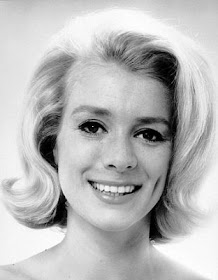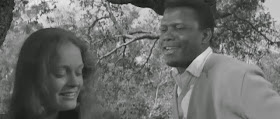Those two words come to mind whenever my thoughts turn to those stars who died young or relatively young, It's not the usual suspects who haunt me - James Dean, Natalie Wood, Steve McQueen, Philip Seymour Hoffman.
No, I think of Carrie Snodgress, for example. True, she wasn't exactly young when she died of heart failure and liver failure in 2004. She was 57. But in my mind, she was still that interesting young actress who commanded attention in a handful of films 30 years earlier, starting with Jack Smight's "Rabbit, Run" and Frank Perry's "Diary of a Mad Housewife" in 1970. Her film career as a major player was painfully short.
In that sense, she died young.
Then, there are two heartbreakers who were indeed young when they passed.
Both suicides.
Frail and incredibly touching, Elizabeth Hartman was arguably the most promising film actress of the mid-1960s, appearing in four diverse films in the space of three years, and then she disappeared, popping up in movies and on TV only occasionally until, sadly, she went away completely.
Time moves on and we tend to forget elusive people like Elizabeth Hartman. When screen writer Gill Dennis, who was married to her from 1968 to 1984, died in 2015, Hartman was just a footnote in his obiturary.
Hartman made her film debut in Guy Green's ”A Patch of Blue,” an unusually unpleasant film about a young blind woman (Hartman) who has an almost accidental relationship with a man (Sidney Poitier) who, unknown to her, is black. Shelley Winters as her cruel mother, Wallace Ford as her cruel grandfather and Elisabeth Fraser as her mother's cruel friend make the film almost unwatchable. But the role brought Hartman an Oscar nomination as best actress. At age 22, she was the youngest person in that category at that time to be nominated for an Oscar.
 A year later, Hartman was part of Sidney Lumet's impressive ensemble in his film version of Mary McCarthy's ”The Group,” playing the key role of Priss. At this early point in her film career, Hartman could do anything she desired. Hollywood wanted her.
A year later, Hartman was part of Sidney Lumet's impressive ensemble in his film version of Mary McCarthy's ”The Group,” playing the key role of Priss. At this early point in her film career, Hartman could do anything she desired. Hollywood wanted her.But she responded instead to a young filmmaker named Francis Ford Coppola who needed a "name" for his New Wave comedy, "You're a Big Boy Now," although the film also featured the estimable Geraldine Page and Julie Harris (with whom Hartman was something of a kindred spirit) and another newcomer named Karen Black. The role was Barbara Darling, a go-go dancer, a vamp and a sadist. And Elizabeth Hartman, to her credit, signed on. It was the only time that Elizabeth Hartman looked glamorous in a film.
And, reportedly, Coppola was forever grateful.
Hartman then went on to do John Frankenheimer's ”The Fixer” in 1968 as part of a British ensemble that included star Alan Bates, Dirk Bogarde, Ian Holm, Hugh Griffith and Georgia Brown. Around this time, Coppola was preparing "The Rain People" and wanted Hartman for the role of Natalie Revenna, a fed-up housewife who runs away from her marriage. But Hartman, always insecure, wasn't emotionally ready for the role and Coppola had to opt for one of Hartman's co-stars from "The Group," Shirley Knight, who rewarded her director with a brilliant performance.
After taking off for a few years, Hartman returned to the screen for Don Siegel in his Clint Eastwood psychological Western, "The Beguiled" in 1971, which also features Hartman's "Boy" co-star, Geraldine Page.
It would be her last role in an important film.
Her next film, had she made it, would have been even more important - and perhaps crucial to her career and her health. She was Coppola's first choice for the role of Kay in his 1972 adaptation of Mario Puzo's "The Godfather." But, again, life got in the way; Hartman remained insecure and emotionally fraught. (The director was reportedly so grateful for her participation in "You're a Big Boy Now" that he wanted to reward her with a showcase female role in a big, largely all-male film.) The part of Kay eventually went to Diane Keaton who is the one weak link in "The Godfather," although in Keaton's defense, it's a poorly written role.
Frankly, I'm not sure that even an actress of Hartman's talent and caliber could have made it memorable.
There were a few roles on television after that, very few. In terms of film, the latter part of Hartman's career included only two roles - in the original "Walking Tall" (1973), a red-neck drama starring Joe Don Baker, and, a decade later, as a voice in the animated "The Secret of NIMH" (1982), made by MGM - the studio that produced "A Patch of Blue."
Hartman went full circle, ending up where she had begun.
Before her suicide in 1987, she worked in a museum in Pittsburgh. Elizabeth Hartman died on June 10th of that year. She jumped to her death from a fifth story window. She was 44.
.jpg) Inger Stevens. Yes, Inger Stevens, whose star - and sweet face - twinkled brightly but briefly
from the late 1950s to 1970 when she died at age 35.
Inger Stevens. Yes, Inger Stevens, whose star - and sweet face - twinkled brightly but briefly
from the late 1950s to 1970 when she died at age 35.She was one of those curious stars whose troubled personal life contrasted sharply with her public persona, which was probably best defined by her role as a plucky Swedish governess opposite William Windom (and the invaluable Cathleen Nesbitt) on the popular TV series, "The Farmer's Daughter," a sitcom with a realistic edge.
Stevens made her film debut in 1957 in the very small Bing Crosby vehicle, "Man on Fire," directed by Ranald MacDougall. She had just turned 20 when she was cast and 22 when it was released, immediately following it with an eclectic collection of titles - Andrew L. Stone's "Cry Terror!" (1958), with James Mason; Anthony Quinn's "The Buccaneer" (1958), with Charlton Heston; MacDougall's "The World, the Flesh and the Devil" (1959) with Harry Belafonte and Mel Ferrer, and an Emmy-nominated role opposite Peter Falk in David Friedkin's "The Price of Tomatoes" (1962), a playlet on Dick Powell's anthology series.
During this period, Stevens reportedly had doomed affairs with most of her leading men, including Crosby, Mason and Quinn.
Like Hartman, the latter part of her career was devoted to television. On TV, she had too many thankless roles. After interrupting her screen work for the small screen, Stevens returned to films in, among others, Gene Kelly's "A Guide for the Married Man" (1967), John Guillermin's "House of Cards" (1968) and, opposite Quinn, in Daniel Mann's "A Dream of Kings" (1969), finally a role worthy of her talents. But it was too little too late.
In less than a year, the ultimately enigmatic Inger Stevens was dead - another Hollywood suicide and also a tragic missed opportunity.
Stevens worked on screen for 14 years. Fourteen years. Way too brief. She left us ... too soon.
 Regarding Comments:
All comments are enthusiastically appreciated but are moderated before
publication. Replies signed "unknown" or "anonymous" are not
encouraged. Please sign any response with a name (real or fabricated) or
initials. Be advised that a "name" will be assigned to any accepted
post signed "unknown" or "anonymous." Thank you. -J
Regarding Comments:
All comments are enthusiastically appreciated but are moderated before
publication. Replies signed "unknown" or "anonymous" are not
encouraged. Please sign any response with a name (real or fabricated) or
initials. Be advised that a "name" will be assigned to any accepted
post signed "unknown" or "anonymous." Thank you. -J
~images~
(from top)
(from top)
~Elizabeth Hartman in a publicity still for "The Group"
~photography: United Artists 1966©
~Carrie Snodgress with Richard Benjamin in a scene from "Diary of a Mad Housewife"
~photography: Universal 1970©
~Hartman with Sidney Poitier in a scene from "A Patch of Blue"
~photography: MGM 1965©
~Hartman as Barbara Darling in "You're a Big Boy Now"
~photography: Seven Arts 1966©
~photography: United Artists 1966©
~Carrie Snodgress with Richard Benjamin in a scene from "Diary of a Mad Housewife"
~photography: Universal 1970©
~Hartman with Sidney Poitier in a scene from "A Patch of Blue"
~photography: MGM 1965©
~Hartman as Barbara Darling in "You're a Big Boy Now"
~photography: Seven Arts 1966©
~Hartman doing her go-go dance in "You're a Big Boy Now"
~photography: Seven Arts 1966©
~photography: Seven Arts 1966©
~Hartman with Clint Eastwood in a scene from "The Beguiled"
~photography: Universal 1971©
~photography: Universal 1971©
~Inger Stevens in a publicity shot for the TV series, "The Farmer's Daughter"
~photography: ABC/Screen Gems Television 1963©
~photography: ABC/Screen Gems Television 1963©
~Stevens with Bing Crosby in "Man on Fire"
~photography: MGM 1957©
~photography: MGM 1957©












